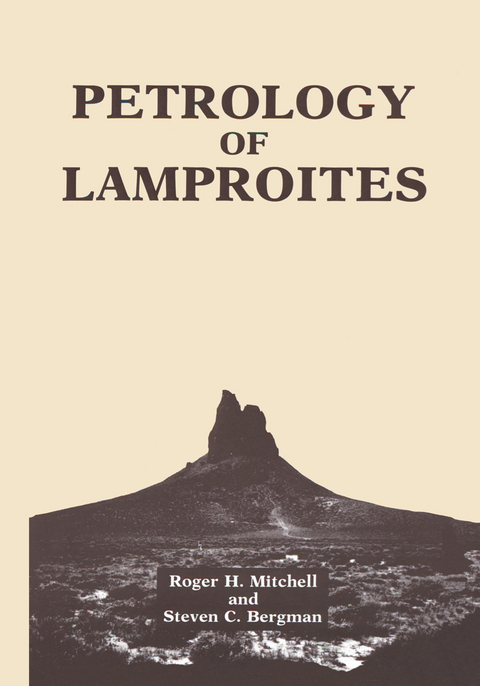
Petrology of Lamproites
Kluwer Academic/Plenum Publishers (Verlag)
978-0-306-43556-0 (ISBN)
1. The Lamproite Clan—Etymology and Historical Perspective.- 1.1. Introduction.- 1.2. Initial Discoveries—1870–1906.- 1.3. Etymology of Lamproite.- 1.4. Western Australian Discoveries—The Legitimization of Lamproites.- 1.5. Johannsen and Modal Classifications of Rocks.- 1.6. Further Developments, New Occurrences, and Diamond-Bearing Lamproites.- 1.7. Reclassification of Anomalous Kimberlites.- 1.8. Recent Developments.- 2. Potassic Rocks and the Lamproite Clan.- 2.1. Alkalinity, Sodic, Potassic, and Ultrapotassic Rocks.- 2.2. Alkali-Alumina Relationships.- 2.3. Potassic Rocks—General Petrographie Characteristics and Terminology.- 2.4. Petrochemical Classifications of Potassic Rocks.- 2.5. Petrographie and Mineralogical Classifications.- 2.6. The Lamproite Clan.- 3. Description of Lamproite Occurrences—Distribution, Age, Characteristics, and Geological Framework.- 3.1. Introduction.- 3.2. North American and Greenland Lamproites.- 3.3. European Lamproites.- 3.4. African Lamproites.- 3.5. Australian Lamproites.- 3.6. Antarctic Lamproites.- 3.7. Asian Lamproites.- 3.8. South American Lamproites.- 3.9. Conclusions.- 4. Tectonic Framework of Lamproite Genesis.- 4.1. Age and Temporal Relations of Lamproite Magmatism.- 4.2. Regional Geological and Tectonic Setting Generalizations.- 4.3. Lithospheric History of Lamproite Settings.- 4.4. Tectonic Framework of Four Mesozoic-to-Cenozoic Lamproite Type-Locality Magmatic Fields.- 4.5. Conclusions and Preferred Model.- 5. Petrological Facies and Igneous Forms of the Lamproite Clan.- 5.1. Introduction.- 5.2. Lava Flow Facies.- 5.3. Crater and Pyroclastic Facies.- 5.4. Hypabyssal Facies.- 5.5. Plutonic Facies.- 5.6. Generalized Model of Eruptive Sequences.- 5.7. Comparison with Kimberlite Diatremes.- 5.8. Summary.- 6.Mineralogy of Lamproites.- 6.1. Phlogopite.- 6.2. Amphibole.- 6.3. Clinopyroxene.- 6.4. Orthopyroxene.- 6.5. Olivine.- 6.6. Leucite.- 6.7. Analcite.- 6.8. Sanidine.- 6.9. Spinel.- 6.10. Priderite.- 6.11. Jeppeite.- 6.12. Iron Titanium Oxides.- 6.13. Potassium Zirconium Silicates.- 6.14. Apatite.- 6.15. Perovskite.- 6.16. Titanosilicates.- 6.17. Minor Accessory and Secondary Minerals.- 7. The Geochemistry of Lamproites.- 7.1. Major Element Geochemistry.- 7.2. Compatible Trace Elements.- 7.3. Incompatible Trace Elements—1: Ba?Sr, Zr?Hf, Nb?Ta, Th?U.- 7.4. Incompatible Trace Elements—2: Rare Earth Elements and Yttrium.- 7.5. Incompatible Trace Elements—3: Alkali Elements.- 7.6. Volatile Trace Elements: Fluorine, Sulfur, and Chlorine.- 7.7. Other Trace Elements.- 7.8. Interelement Relationships.- 7.9. Isotopic Composition.- 7.10. Summary.- 8. Experimental Studies Relevant to the Formation and Crystallization of Lamproites.- 8.1. Low-Pressure Studies of Lamproites.- 8.2. High-Pressure Phase Relationships of Natural Lamproites.- 8.3. Synthetic Systems.- 8.4. The Oxidation State of Lamproite Magmas.- 8.5. Summary.- 9. Diamonds, Xenoliths, and Exploration Techniques.- 9.1. Diamonds and Xenoliths: Alien, Yet Beneficial, Companions of Lamproites.- 9.2. Diamonds.- 9.3. Xenoliths and Xenocrysts.- 9.4. Exploration Techniques for Diamondiferous Lamproite.- 10. Petrogenesis of Lamproites.- 10.1. Introduction.- 10.2. Previous Petrogenetic Models.- 10.3. Genesis of the Lamproite Clan.- 10.4. Relationships to Kimberlites.- 10.5. Relationships to MARID-Suite Xenoliths.- 10.6. Relationships to Other Potassic Rocks and Lamprophyres.- 10.7. Summary.- Postscript.- References.
| Erscheint lt. Verlag | 30.6.1991 |
|---|---|
| Zusatzinfo | XVI, 447 p. |
| Verlagsort | New York |
| Sprache | englisch |
| Maße | 178 x 254 mm |
| Themenwelt | Naturwissenschaften ► Geowissenschaften ► Geologie |
| Naturwissenschaften ► Geowissenschaften ► Mineralogie / Paläontologie | |
| ISBN-10 | 0-306-43556-X / 030643556X |
| ISBN-13 | 978-0-306-43556-0 / 9780306435560 |
| Zustand | Neuware |
| Haben Sie eine Frage zum Produkt? |
aus dem Bereich


